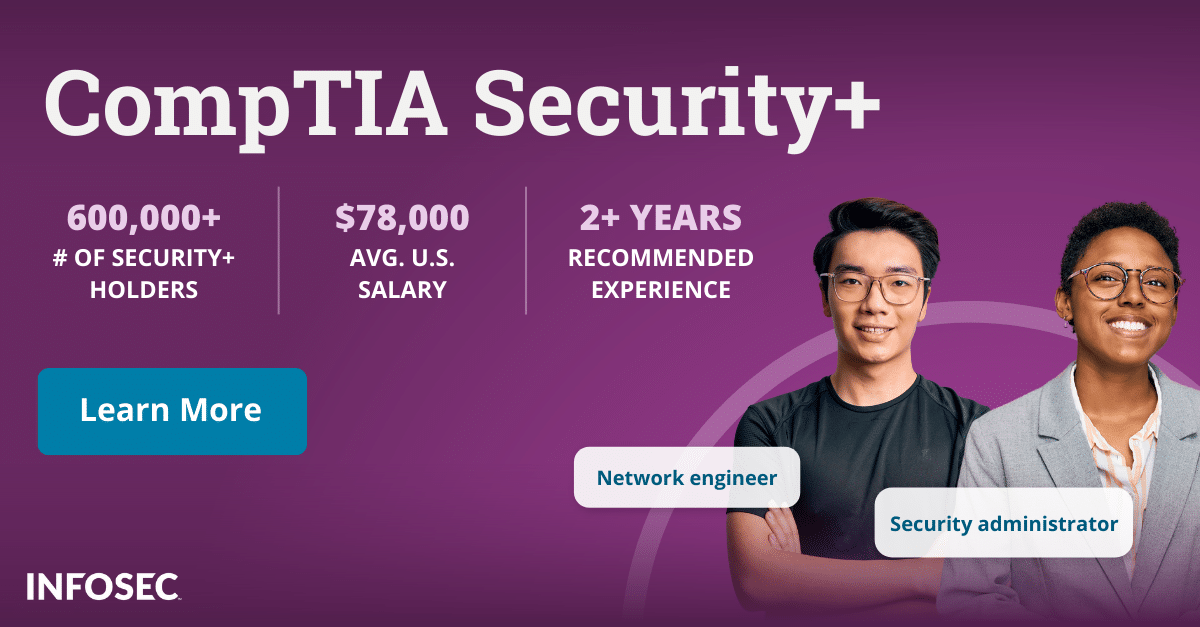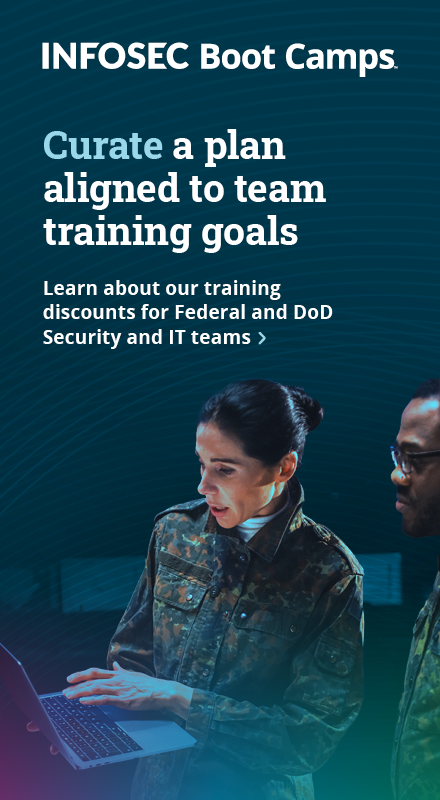Security+ domain 5: Understanding security program management and oversight (701 exam update)
The CompTIA Security+ certification is a well-respected credential that validates your foundational knowledge in cybersecurity. The exam undergoes revision approximately every three years to ensure it reflects the latest security threats and industry best practices. The most recent update, the SY0-701 exam, was launched in November 2023. The previous version, SY0-601, is no longer valid as of July 31, 2024.
This blog post will examine domain 5 of the exam, security program management and oversight. This domain has been reorganized and substantially updated compared to the previous version. We'll explore these changes in detail and provide an overview of the knowledge required to master this area on the new exam.
What's changed in Security+ domain 5?
As Patrick Lane, Director of Certification Product Management at CompTIA, highlights in CompTIA Security+: Everything you need to know about the SY0-701 update, Security+ domain 5 covers "security program management and oversight where you have to understand effective security governance and what that entails." It plays a central role in ensuring an organization's overall security posture.
The new domain groups related concepts together, making it easier to grasp the bigger picture. Here's a breakdown of its subdomains and how they compare to the older SY0-601 exam:
- 5.1: Summarize elements of effective security governance: This combines aspects of security policies and procedures, previously in domain 4 of the older exam, with the concept of aligning security practices with a chosen framework, which was subdomain 5.4 in the 601 exam.
- 5.2: Explain elements of the risk management process: This objective remains relatively the same but moved from subdomain 5.4 in the older exam.
- 5.3: Explain the processes associated with third-party risk assessment and management: This objective explains the importance of policies to organizational security from the older SY0-601 exam and adds material on summarizing risk management processes and concepts from objective 5.4 in the older exam.
- 5.4: Summarize elements of effective security compliance: This subdomain merges "explain the importance of applicable regulations, standards or frameworks that impact organizational security posture" and "explain privacy and sensitive data concepts in relation to security," which were separate objectives in module 5 of the older 601 exam.
- 5.5: Explain types and purposes of audits and assessments: Material from objective 1.8, "explain the techniques used in penetration testing," and objective 5.2, "explain the importance of applicable regulations, standards or frameworks that impact organizational security posture," in exam SY0-601 were combined to create this subdomain.
- 5.6: Given a scenario, implement security awareness practices: This subdomain combines new material with the 5.3 objective in exam 601, "explain the importance of policies to organizational security."
Now let’s explore each of these objectives in detail.
Watch the full Security+ webinar with CompTIA to learn more.
5.1: Effective security governance
The first objective, "summarize elements of effective security governance," lays the foundation for this entire domain. As Lane mentioned, it's about understanding how to establish and maintain strong security practices. This involves aligning your organization's security efforts with a chosen framework or regulation. It also means creating and enforcing policies, procedures and standards that address critical areas like password management, access control and incident response.
Effective security governance ensures everyone in the organization understands their roles and responsibilities when it comes to protecting data and systems. This includes not only internal policies but also external considerations like relevant laws and industry best practices. By establishing a clear governance structure, you can ensure your security program is continuously monitored, reviewed and improved. Understanding these core elements is essential for anyone involved in designing, implementing or overseeing an organization's security posture.
5.2: Risk management process
This objective, "explains elements of the risk management process," dives into a critical security function. It's all about identifying potential security threats lurking in your organization's IT infrastructure. But that's not all it covers. You also learn how to assess these risks, gauge their likelihood and determine their potential impact. This allows you to prioritize them and develop effective strategies to lessen their severity.
As Lane explained, "A big part of risk management is reporting the risks that you find in the network because that will help determine how secure your network is." Clearly communicate identified risks, and you can inform decisions about security controls and resource allocation. Mastering risk management enables you to make informed choices about how to best safeguard your organization's valuable assets.
5.3: Third-party risk assessment and management
The objective "explain the processes associated with third-party risk assessment and management" addresses a growing concern in today's interconnected digital landscape. Many organizations rely on vendors and partners for critical services, but these third parties can unknowingly introduce security vulnerabilities. This objective explores how to assess these potential risks.
You'll learn about selecting vendors with a focus on their security posture, conducting thorough due diligence processes and leveraging tools like penetration testing to uncover hidden weaknesses. The key here is continuous monitoring. By regularly evaluating your vendors' security practices through questionnaires, audits and enforcing clear rules of engagement, you can ensure they align with your organization's security standards. Effectively managing third-party risk extends your security beyond your own walls, creating a more robust security posture.
5.4: Effective security compliance
Don't get caught up in just checking boxes! This objective, "summarize elements of effective security compliance," emphasizes understanding the regulations and standards that impact your organization's security. It's about aligning your security controls with these frameworks and then demonstrating your follow-through.
"You have to understand security compliance," said Lane. "What does it mean to comply? If you've implemented the security controls and you can prove that you've implemented them, you are showing compliance to a particular control." This objective covers various compliance aspects, including reporting requirements, the potential consequences of non-compliance, and how automation can streamline monitoring efforts. When you master effective security compliance, you can navigate the legal and regulatory landscape with competence and protect your organization's data and reputation.
5.5: Audits and assessments
The objective "explain types and purposes of audits and assessments" equips you to understand the role of independent evaluations in security. Regular audits and assessments are crucial for identifying weaknesses in your security posture. Lane highlighted that audits act as a kind of verification tool in that they help confirm that your implemented controls are working effectively.
This objective explores different types of audits, including internal compliance Audits and external regulatory examinations. You'll also learn about penetration testing, a simulated attack that helps uncover vulnerabilities before malicious actors can exploit them. Understanding the various types and purposes of audits and assessments will help your organization proactively identify and address security risks.
5.6: Security awareness practices
This objective, "given a scenario, implement security awareness practices," goes beyond memorizing security policies. It focuses on your ability to apply those policies in real-world situations.
This section of the module examines how to identify and respond to phishing attempts, a common tactic cybercriminals use to steal data or gain access to systems. You also learn about recognizing other risky user behaviors and how to create a culture of security awareness within your organization. This includes employee training programs, clear policies on password management and removable media and promoting situational awareness to identify potential social engineering attacks.
In today's hybrid and remote work environments, these practices are more important than ever. By effectively implementing security awareness practices, you can enable employees to become your first line of defense against cyber threats.
Preparing for your Security+ exam
Domain 5, security program management and oversight, plays an essential role in the Security+ exam. Understanding how to establish and maintain a strong security program is a valuable asset for anyone in the IT security field. This domain carries a 20% weight on the exam, so make sure you're comfortable with the concepts covered here.
But Security+ is a comprehensive exam encompassing a broader range of security topics. Be sure not to neglect the other essential domains that will be tested:
- Domain 1: General Security Concepts
- Domain 2: Threats, Vulnerabilities and Mitigations
- Domain 3: Security Architecture
- Domain 4: Security Operations
To solidify your understanding of these domains, we recommend exploring the following resources:
- Gain valuable insights from industry experts in our webinar, CompTIA Security+: Everything you need to know about the SY0-701 update.
- Learn more about the details of the Security+ SY0-701 exam in our free Security+ ebook.
- Explore a wide range of learning materials, including in-depth articles on various aspects of the Security+ certification in our Security+ certification hub.
Leveraging these resources and diligently studying all the domains is the first step in conquering the Security+ exam and moving your cybersecurity career forward.



